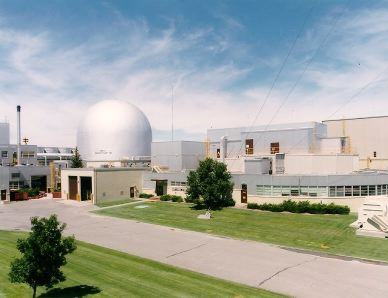Thorium (Th) is a good nuclear fuel. That weakly radioactive element is easier to handle than uranium (U). Its waste remains for a shorter time than U-235 waste. If we want to use Thorium as the fuel in conventional nuclear reactors, that is ok. Th.232 turns into U-233 when nuclear fission neutrons impact it. Thorium acts in the same way Uranium 238 turns into Plutonium, Pu-239 in neutron bombardment.
Th-232 catches free neutrons and turns into U-233. That chain is a little bit more complicated. But finally, the Th-232 turns into the Uranium 233. It's possible to make the Thorium-based fast breeder reactor. Normally fast breeder reactor turns U-238 into Pu-239. The fast breeder reactor should have the capacity to handle Th-232, as it handles U-238.
"Experimental Breeder Reactor II, which served as the prototype for the Integral Fast Reactor" (Wikipedia, Breeder reactor)So Thorium can make it possible to create new types of nuclear weapons. The U-233 is suitable for nukes, as well as Plutonium. The small, subcritical fission weapon can send neutrons into the Thorium stage. That thing changes the Thorium into U-233 immediately, and it starts nuclear fission. In that model the natural Uranium shell. That used to boost fission bombs is replaced with Thorium. The reaction should be similar to when the fission booster sends fast neutrons into the U-238 shell.
 |
Above: Liquid Metal cooled Fast Breeder Reactor (LMFBR) (Wikipedia, Breeder reactor)
Of course, it's possible to create Uranium 233 using nuclear reactors. This system requires a hard radiation shield. The reason is that the Uranium 232 is a very strong gamma source. The centrifugal systems can separate the U-232 from the U-233.
But it's possible that the Uranium 233 bites are far away from each other, and they are cut into smaller pieces. In those weapons, the system uses the shield that is used in plutonium bombs. U-233 sends more neutrons than U-235. And that makes it suitable to work as a neutron source. That means it can used as triggers. Thorium opens new and interesting paths to nuclear power. But it can also be a tool of destruction.
https://en.wikipedia.org/wiki/Breeder_reactor
https://en.wikipedia.org/wiki/Fissile_material
https://en.wikipedia.org/wiki/Liquid_metal_cooled_reactor
https://en.wikipedia.org/wiki/Plutonium
https://en.wikipedia.org/wiki/Thorium
https://en.wikipedia.org/wiki/Uranium






No comments:
Post a Comment
Note: Only a member of this blog may post a comment.